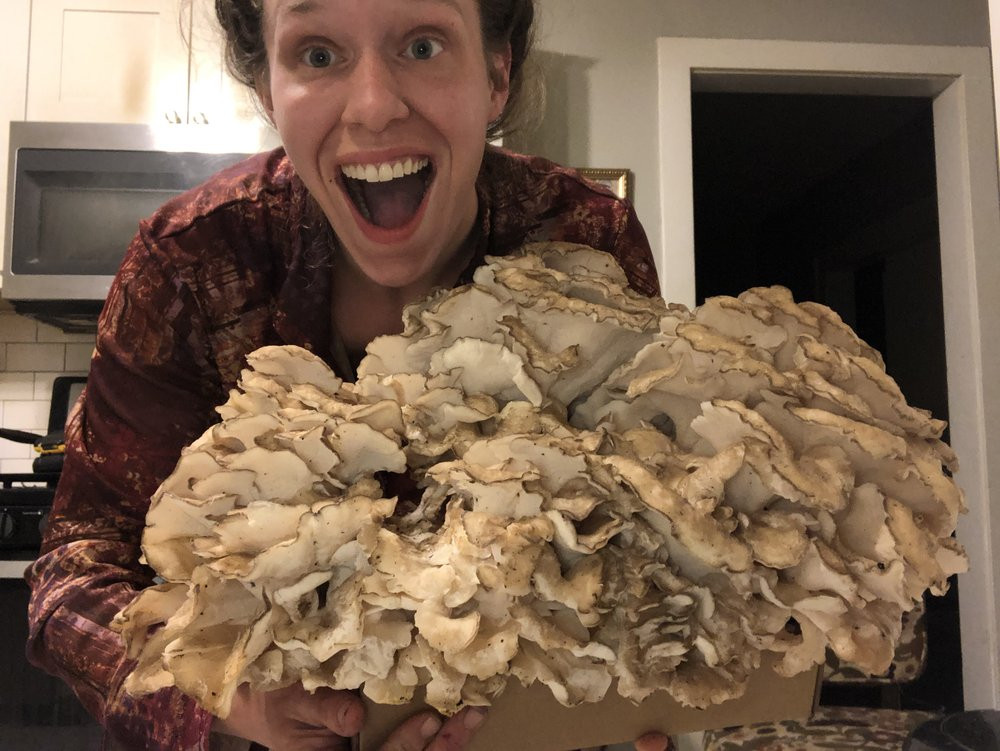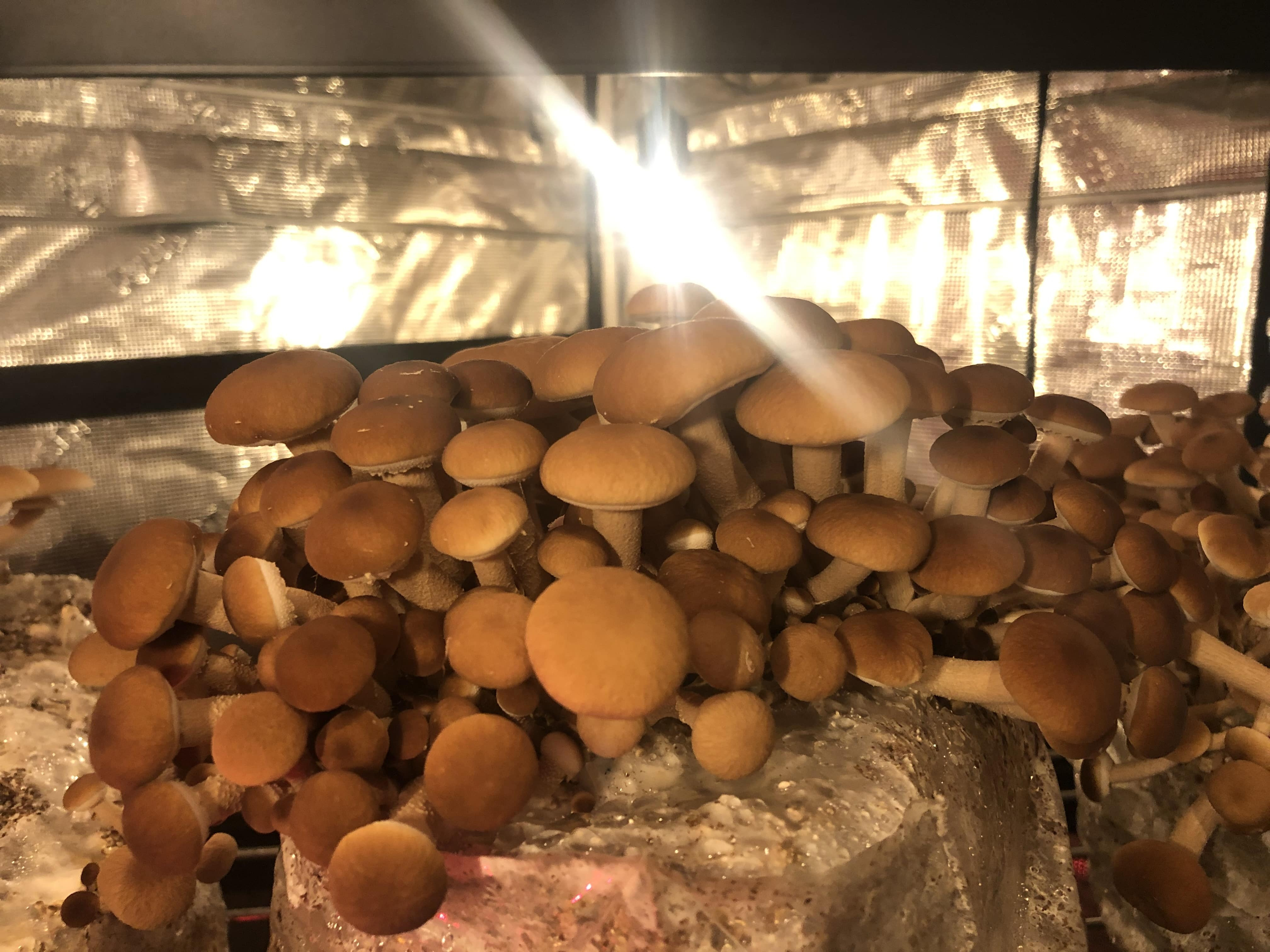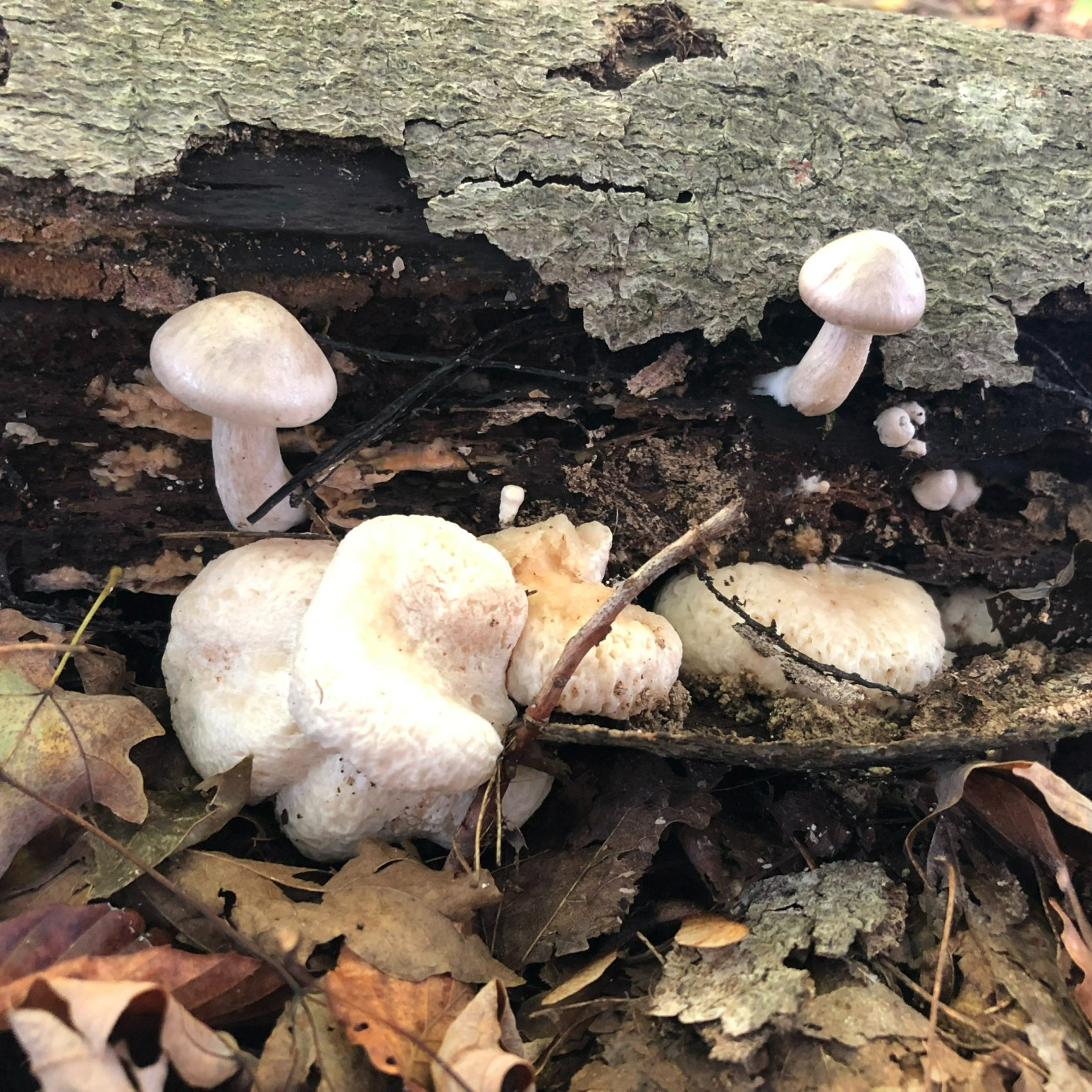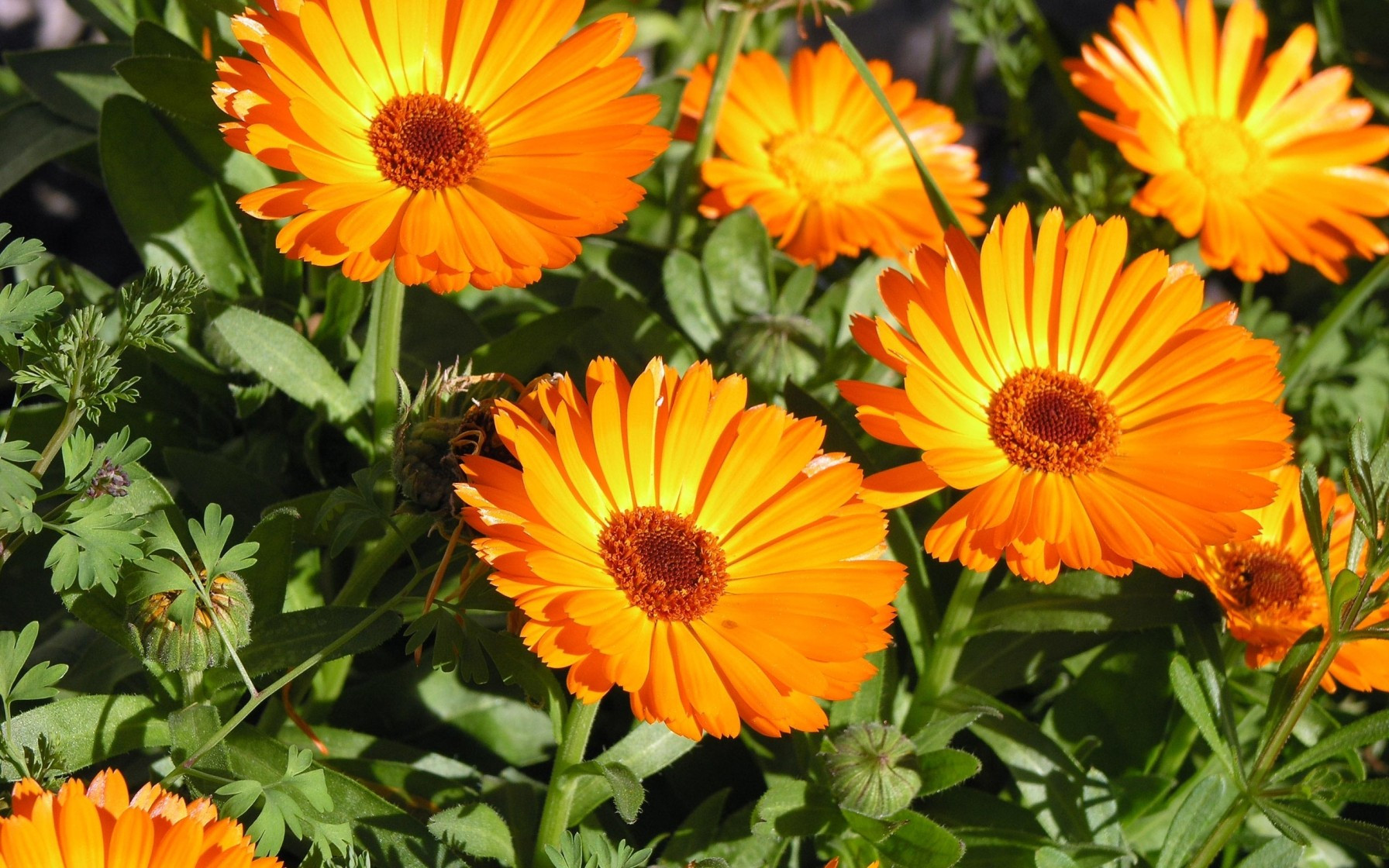Meet Mushroom Farmer - Emma Jackson of Forage and Cultivate
posted on
September 4, 2022

Emma Jackson of Forage and Cultivate holds a basket full of foraged chanterelles she picked from her parents' property. She likes to make savory apple pies with these chanterelles paired with ginger and sweet onion.
The pandemic changed trajectory for so many people. For Emma, it uprooted her plans to stay in neuroscience research, and instead, found her turning up a new career and a new company called Forage and Cultivate!

Visit Forage and Cultivate's Website
Prior to the pandemic, Emma was busy enjoying a robust academic career with a focus on finishing a chemistry and neuroscience degree. With a psychology degree already under her belt, she had been working full time as a court-ordered substance use case manager. She had her eye set on earning a PhD in addiction neuroscience after working in a neuroscience lab studying HAP mice (high alcohol preferring mice) that were bred to choose alcohol over water from birth. She had applied to some PhD programs but kept getting waitlisted.
Then the pandemic hit.
Emma sensed a calling to leave academia for the great outdoors. It's a decision she doesn't regret, "I LOVE IT! It's so much more rewarding than being at a desk!"

Emma is self-taught in the school of mushroom hunting after spending many years studying mushroom identification books and foraging on her own to know how to spot the safe, edible ones.

"You learn tricks and learn to spot the look-alikes. Like a false chanterelle has a yellow middle." If there are any questions, she has perfected a "spore print test" to indicate deadly mushrooms so her business and her customers stay safe.
In 2021, her dreams of starting a gourmet and medicinal mushroom and edible plant shop began to bloom. 
Her goal was to do things differently than the chemicalized commercial world of mushroom production... Instead, she uses all organic, nonGMO, clean products and hauls in tons of sterilized water and all natural house-cured hardwood chips harvested from nearby woods.
Her desire to be different has paid off. She's already found 10 local restaurants who use her mushrooms and edible flowers (nasturtiums) for their dishes like this ramen dish with added shitakes from the Indianapolis-based restaurant Strangebird.
Emma admits that most at-home cooks may not realize what it takes to get the right flavor from a mushroom. She says a mushroom is 90 percent water and since "water and oil don't mix," before you add oil or butter to your pan, let mushrooms heat up on medium low heat to help them vaporize so they can sponge up the oil. "A correctly cooked mushroom should be crisp! Roasting or baking is a great way to prepare mushrooms, reduce in size and impart flavors."
Clearly her chemistry background comes in handy.
"Not only do I forage, I clone what I find in the woods and sell. Native species. I breed two local oysters to produce my own."
 She currently works out of her garage but is moving to a Pole barn and will increase production from 20 pounds of mushrooms to 500 pounds every few weeks!
She currently works out of her garage but is moving to a Pole barn and will increase production from 20 pounds of mushrooms to 500 pounds every few weeks!
Emma also sells "agar plates" of mushroom starters for other mushroom cultivators like herself and a special all-natural Calendula Oil and Lotion to the general public.
"Calendula flower is an antifungal, anti-microbial, antibacterial agent... I've been making calendula lotion and oil for over 8 years for my friends and family. They use it for a host of reasons i.e. skin burns from the sun, preventing skin burns, treating burns from heat, acne prevention and treatment, toe fungus treatment, eczema treatment, application to fresh wounds to prevent scar formation. All in all it's an amazingly powerful topical skin treatment. It can be applied to open dirty wounds as it heals the skin from the inside out. I also sell comfrey salve which is better for scar reduction and bruised muscles and aching joints. It cannot be applied to open wounds as it heals from the outside in and causes rapid skin cell generation which can trap bacteria inside the wound."
 Farming mushrooms is not only a physically intensive job but also it can be a surprisingly dangerous job too. Emma wears a mask to protect herself and the mushrooms.
Farming mushrooms is not only a physically intensive job but also it can be a surprisingly dangerous job too. Emma wears a mask to protect herself and the mushrooms.
"Growing mushrooms release millions of spores. If over time a harvester breathes in loads of spores in their tent, they will find themselves with 'spore lung' which causes mushrooms to grow inside of our lungs and can be deadly. It's a common issue overseas in mushroom production where large scale producers don't provide their harvesters adequate equipment."

She also wears a painter's mask when she's in the laboratory or in the grow room to keep from contaminating the agar plates or mushroom bags with natural bacterial spores that we as humans exhale with every breath!

Ultimately, Emma says while she seeks to better the lives of others, the benefits have come back full circle, "I've gotten away from the desk and back to using my hands and feet to apply the knowledge set I learned in the labs on campus. I get to take some of the most breathtaking components of our native woods here in Indiana, the fungi, and attempt recreating their habitat indoors. Cloning native species and seeing how they grow underscores for me not just how intelligent and adaptable the fungal kingdom truly is but how much they have in store to teach me in the years to come."
Want to see what she's learning from mushrooms?
Read below as she describes characteristics of the native mushrooms she currently cultivates:
King Oysters are known to be the best oyster for flavor and texture. Typically, they are used for mock vegan scallops. The large stalk is chopped thick and stir fried accordingly. Other people like to pull them apart, like pulled pork, as they have a good meaty consistency. They are opposite most mushrooms as they are grown for their stalk. Typically, when judging the quality of a mushroom you're looking for a little stalk and a lot of cap- not so with the King's.

Lion's Mane are wildly popular right now for their neurogenerative properties. Specifically in that they help the brain produce NGF (nerve growth factor). Studies dating back to the early 90's reveal Lion's Mane intake reduces chances for developing, and symptoms of, Alzheimer's and dementia. As a food, it's known to have a fishy flavor. It's often prepared as mock crab cakes or battered and fried like fish. It can also be sliced like cauliflower and fried in a similar manner to cauliflower steak. You can tell the quality of a Lion's Mane by how hairy it is. It's become popular to top fruit Lion's Mane in which you get a big hairy mass without a lot of lobular distinction. I find high quality Lion's Mane will be lobular and should be pulled before the hair is so massive.

I love foraging for Wild Maitake! But I am experimenting with growing it too. Its most prominent medical property is its ability to drop blood sugar levels. In fact, it can drop blood sugar levels so well that if you are on blood sugar medication you should consume it with caution as it can plummet the levels too low in combination and cause some issues. Studies also found it to be a more effective treatment for HIV than AZT (back in the day when AZT was still valued). The flavor of Maitake/Hens is phenomenal. It grows in a stag like shape. The main compound within it, constituting over 50% of its fruit body, is a polysaccharide denoted 'Grifolan.' That's why it's real name is Grifola Frondosa. The Frond refers to the leaf shape it produces when expanding and the grifola refers to it's main sugar compound. I love how a polysaccharide is responsible for dropping blood sugar levels.

The Black Poplar/Pioppino is only found in a few southern states here in the US like Mississippi and Louisiana. It carries a nutty flavor and is well loved as both the cap and stem are delectable. Most mushrooms the stem is thrown out in preparation. The black poplar keeps a firm crispy texture when it is cooked. It generally supports the immune system by aiding in cytokine and interleukin production.

The Shiitake Mushroom is a very popular and well known mushroom. It must be cooked longer than six minutes to properly vaporize the formaldehyde within its fruiting body. It's pretty amazing this mushroom has developed such a way to increase its survival skills in the wild. Eating shiitake promotes better gut function and has been found to aid in stomach cancer. They can reduce cholesterol levels by inhibiting cholesterol absorption through the stomach lining. They are another anti-inflammatory mushroom and they are one of the richest natural foods in copper and selenium.

I wish more people would look to the Reishi mushroom for its health benefits as well. It's popular to want to maximize brain function but without good circulation and supporting the rest of the body what's the purpose?

If you're a foodie, you may like to head over to Indianapolis sometime and try these restaurants that incorporate the edible flowers and mushrooms that Emma forages and grows:
128 S Audobon Rd, Indianapolis
instagrams are @strangebirdindy, @shoyu.shop.indy, and @thekylemachine
Chef Kyle Humphreys is known for making all of his own ramen noodles in house and incorporates a lot of mushrooms into his dishes. Forage and Cultivate's biggest and longest restaurant supporter.
401 S. College Ave, Indianapolis
They buy mushrooms in the fall and spring and winter to sell in their grocery and they also use Forage & Cultivate's foraged mushrooms on their menu (right now they use chanterelles). They also have used F & C's nasturtiums to garnish their drinks of the month through the summer.
2830 E Washington St, Indianapolis
This creative restaurant that makes "traditional Mexican dishes reinvented with a modern take on flavor" is very supportive and excited to regularly use Forage & Cultivate's native mushrooms in their dishes, including a vegan cochinita pibil which is a "traditional Yucatec Mayan slow-roased pork dish."
3301 E Tenth St, Indianapolis
They've been using Forage & Cultivate's pink oysters to make pink oyster bacon BLT's.
653 Virginia Ave, Indianapolis
A restaurant named from a Kurt Vonnegut book. They have paired nasturtiums with their steaks in the past.
1844 E Tenth St, Indianapolis
Forage & Cultivate has only been able to work with them once due to the restaurant's quantity needs but Emma hopes after she expands her production, she can work with them regularly.
# # #






